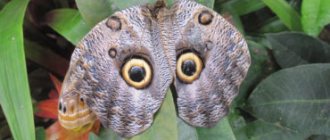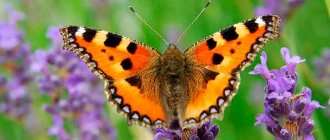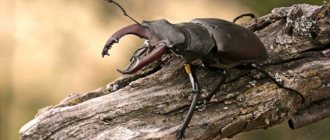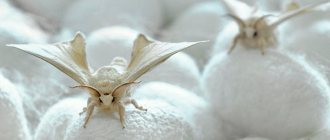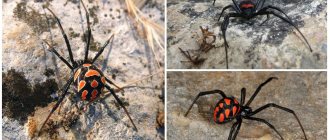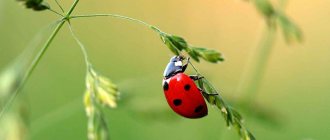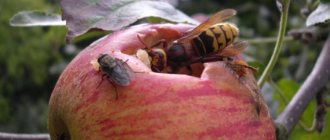Description and features
Dragonflies are flying predatory insects. They belong to the order of dragonflies, which has more than 6,000 species. The sizes of insects, depending on the species, range from 1.5 to 15 cm, and the wingspan is from 2 to 19 cm. The appearance of the dragonfly is easily recognizable. The insect has a large head with large eyes, short antennae, powerful mouthparts, chest, abdomen, three pairs of legs and two pairs of wings. Body color can be very different; dragonflies of various colors are found in the world. Some of them have a metallic sheen to their body.
Appearance
The dragonfly's head is very mobile and can rotate 180⁰. The eyes consist of a large number of facets (from 10 to 27 thousand). The lower rows of eye elements can only perceive the colors of objects, and the upper ones their shape. There are 3 simple eyes located on the crown. This structure and location of the eyes makes it possible for the dragonfly to survey the surrounding space not only in front of itself, it sees what is happening from the side, above and even behind.
But with the other senses the situation is much worse. Insects have a very weak sense of smell, and hearing is practically absent. The gnawing type oral apparatus is formed by strong, durable jaws, which are covered by the upper and lower lips.
The main feature that distinguishes dragonflies from other insects is their elongated abdomen, which makes up most of the body. The wings are large, transparent, consist of 2 layers of chitin and have many overlapping veins.
The tarsi consist of 3 segments, each of which is covered with small spines. The dragonfly needs its paws for grasping and holding prey, as well as for taking off and landing. Insects practically do not use them to move. During flight, the legs fold into the shape of a basket. This helps the insect instantly grab prey that gets in its way.
Breeding dragonflies large rocker
Dragonflies have an incomplete metamorphosis cycle. First they go through the egg stage, then nymphs and adults.
Each male has his own territory; he regularly flies around his area and does not allow rivals to enter it.
During mating, the male grabs the female by the head with his anal appendages. The sperm is pumped into a special organ on the second abdominal segment. The female presses her genital opening to the copulatory organ.
The female lays eggs on aquatic plants. She goes down the stem and sticks one egg at a time into the stem, which is under water. Also, a female dragonfly can lay eggs in accumulations of dead plants on the shore of a pond or on the inside of the leaves of water lilies.
Why does the dragonfly have a big rocker? It received this name due to the position of the females; they bend their abdomen in the form of a rocker if they refuse to mate.
Dragonfly larva large rocker
Dragonfly large rocker lays eggs
Dragonfly large rocker on aquatic vegetation
Kinds
All dragonflies are divided into 3 subspecies:
- Homoptera - this includes the smallest insects with an elegant body and wings of equal length;
- heteroptera - in this category, the rear pair of wings has an expanded base, thanks to which they can develop high speed;
- anisozygoptera is a rather rare group living in Japan, Nepal and Tibet; representatives of this subspecies combine the characteristics of the previous two.
The most common species of dragonflies belonging to Homoptera are:
- beauties;
- arrows;
- Lutki;
- planipedes.
The suborder heteroptera includes:
- grandfathers;
- grandmothers;
- rocker arms;
- club-bellies;
- Flat bellies.
Flat-bellied
All dragonflies are amphibious, that is, at different stages of development they live in water and on land. In the aquatic environment, eggs develop and larvae, which are otherwise called naiads, grow; the life activity of adults takes place in the air and on land.
Origin of the species and description
Photo: Dragonfly
Odonata or dragonflies are predatory insects belonging to the phylum Arthropoda, subclass of winged insects and order Dragonfly. This detachment was first described by Fabricius in 1793. Dragonflies are a very large order, which includes 6,650 species. Currently, 608 species are classified as extinct, and 5899 species of these insects inhabit our planet in modern times.
The dragonfly order is divided into 3 suborders:
- heteroptera;
- Homoptera;
- anisozygoptera.
Dragonflies are a very ancient group of insects. The first dragonflies inhabited the earth back in the Carboniferous period of the Paleozoic era. These insects are descended from the giant dragonfly-like insects Meganeura. Meganeuras were large insects with a wingspan of up to 66 cm. These insects were considered the largest insects of ancient times. Meganeura later gave birth to the following groups of their descendants: Kennedyina and Ditaxineurina, these groups of insects lived in the Triassic period of the Mesozoic era. They were large; the wings of these insects were about 9 cm long. During rest, they folded under the abdomen of the insect.
Video: Dragonfly
The insect also developed a trapping basket, used for grasping prey. During the Jurassic period, the following groups came: Lestomorpha and Libellulomorpha in these insects, the larvae developed in an aquatic environment and they had an improved flying apparatus. Insects of the Libellulida group inhabited Africa, South America and Australia in the Triassic period. Meganeuras still lived in Eurasia at that time, but during the course of evolution their bodies and habits changed. In the Jurassic period, meganeurins reached the pinnacle of evolution and populated all of Eurasia. These insects had a “catching basket” and could use it to hunt during flight. Gas exchange in this group was carried out using the respiratory epithelium, but there were also lamellar gills, which changed over time, ceased to perform a gas exchange function and were replaced by internal gills.
At the same time, the descendants of the family Calopterygoidea have evolved greatly from the original state. The wings of these insects narrowed, became stalked and the size of the wings became the same. In the Jurassic period, insects of the suborder Anisozygoptera become the most common; their numbers sharply decrease during the Cretaceous period, but this group remains widespread throughout the entire polygenic period. During this period, such species of dragonflies as Coenagrionidae, Lestidae and Libelluloidea, etc. almost disappear. The Cenozoic fauna is already inhabited by modern species of dragonflies. During the Neocene, the ethnofauna was no different from the modern one. The Zygoptera population declined sharply, but Coenagrionidae and Lestidae became the most common species.
Lifestyle and habitat
Dragonflies live in almost all corners of the globe; they are not found only in Antarctica, Greenland, Iceland and the islands of the Arctic Ocean. The wide distribution area is due to the ancient origin of insects, their ability to move quickly and over long distances, as well as the lack of food specialization.
Insects prefer warm regions with high humidity. Dragonflies live only in those areas where periods with stable negative temperatures last no more than 90-120 days.
The habitat of dragonflies is closely related to water bodies, since it is on water that females lay their eggs. The choice of pond is largely determined by the type of insect. These can be lakes, rivers, ponds and even flooded ravines or pits. The larvae, emerging from the eggs, grow and develop in water, and the adult dragonfly, having laid a clutch, can remain nearby or fly away over a long distance, measured in hundreds of kilometers, and most often the flights are made alone.
You can meet a dragonfly in nature in any open area, for example, on a forest edge or in a meadow. This is due to the fact that it is very important for the insect to be exposed to the sun. Dragonflies are diurnal, going out to hunt in the morning or evening. As night approaches, they hide in the grass or in the crown of trees.
Lifestyle
Insects are excellent flyers; they can reach speeds of up to 55-60 km/h. Their flight is characterized by planning. While looking for prey, dragonflies are able to hover in the air for a while. They fly several kilometers in search of comfortable habitats. Dragonflies are active during the daytime. They love warm sunny days. On a cool morning, adults can be seen basking in the rays of the rising sun. The great rocker is one of the species that are active not only during the day, but also after sunset. They spend the night on the treetops. The adult summer period is from July to September.
Dragonflies are reliable human assistants in the fight against blood-sucking insects. Adults destroy mosquitoes and gadflies on land, and nymphs destroy mosquitoes in bodies of water where pests lay eggs. In a swift flight, dragonflies in flight grab flies and mosquitoes with their paws, and can catch a butterfly or even a small dragonfly.
Information. In some cases, dragonflies cause harm to humans. The adults prey on bees, and the larvae seriously harm young fish.
The larvae thrive in stagnant or low-flowing water with a large number of plants. Weak limbs prevent nymphs from traveling and pursuing prey. They hunt from ambush. During the throw, the larva releases a stream of water, which sharply throws it forward towards the prey. Its breathing mechanism is designed so that the tracheal gills are located in the rectum. The nymph swallows a large amount of water and receives oxygen, the liquid is excreted through the anus. To capture prey, the larvae have a special organ called a mask. This is a modified lower lip, equipped with a movable joint and grasping teeth.
Interesting fact. The nymphs of the large rocker are very voracious; during the day they absorb an amount of food that exceeds their own weight.
After 2 years of development, the larva moves to land, where it settles on a vertical surface for its final transformation. Her skin dries out and cracks on her back. A dragonfly emerges from the old, tight skin. Her wings are soft and unformed. They wait for several hours for their wings to spread and harden. The final coloring takes several days to complete.
Nutrition
Dragonflies are aggressive predators that pose a danger to many species of insects (mostly flying ones). They even attack those larger than them, and in most cases successfully. Interestingly, most species eat prey on the fly while in the air. They are very voracious, so they eat several dozen insects per day, the total weight of which significantly exceeds their own weight.
So, what do adult dragonflies eat:
- mosquitoes;
- flies;
- midges;
- beetles;
- spiders;
- moth;
- dragonflies.
These insects can be divided into several categories according to their hunting method:
- free upper tier predators - species that can fly high, lie in wait for prey at a height of 2 - 9 m above the ground;
- free hunters of the middle tier - hunt at a height of 0.5 - 2 m above the ground, most often circling over bodies of water, only occasionally resting on the grass or plants sticking out of the water;
- lying in wait hunters - sit in ambush on blades of grass or bushes, waiting for a prey flying past, and when they notice it, they suddenly take off and attack;
- grazing predators - hunt in thickets of grass, flitting from place to place in search of prey, having caught it, they eat it while sitting on a plant.
Dragonfly larvae feed on fish fry, leeches, insect larvae, tadpoles, and small crustaceans.
How do dragonflies hunt and what do they eat?
During your life, you have probably at least once observed the behavior of such an amazing insect as a dragonfly. You will especially often see these flying creatures somewhere near a pond or other body of water, where they feel especially free and as natural as possible.
By the way, at first glance, many will think that dragonflies simply float aimlessly over the water and fly wherever they please. According to Krylov’s fable about the dragonfly, many prefer to think that in life it is the same carefree and frivolous insect that exists for its own pleasure.
But such an opinion should be called completely erroneous. Because it cannot be said that dragonflies circle groundlessly over water bodies for a long time, since for them this process does not look the same as it appears for humans.
Dragonflies at this time act as real hunters, and as long as we see dragonflies in this state, we must conclude that they hunt almost constantly. This should be explained by the fact that the dragonfly can certainly be called a rather voracious creature. One gets the impression that she is constantly hungry and is always looking for additional food.
If we talk about what a dragonfly eats to get enough, then there is no clear option. It seems that no product will completely satisfy the taste buds of the hunter. Right during the flight, she eats her prey in the form of small insects.
If we talk about larger victims, then here she may not be so lightning fast and agile. To catch larger prey, a dragonfly may even pause for a while. But in human eyes, this will still be a very fast process, since the dragonfly will not stand on ceremony with its victims. She instantly deals with them and then flies off in search of her next prey.
Such dragonflies already prefer small fish; they also hunt spiders and even frogs. If we consider dragonfly larvae, then in their gluttony they are in no way inferior to their older brothers. Their natural habitat is water.
The moment an individual dragonfly notices any kind of living creature, it will immediately quickly straighten its lower lip, protruding it forward, and thus deftly grab its prey. It takes from a year to a maximum of three years for the larva to develop into an adult insect. But as soon as another young individual, a new representative of their species, appears in a row of dragonflies, it immediately begins the hunting process.
https://youtube.com/watch?v=qmTA_9X_AnE
Nature itself has created a truly dangerous predator from this insect. The entire body of a dragonfly is completely designed in such a way that hunting is not difficult for it, since it does it easily, and, most importantly, in an effective manner. Nature has endowed the dragonfly with eyes of incredible size.
Since dragonflies have jagged jaws in their mouths, the insect quickly breaks the body of its prey. And thanks to its wings, a dragonfly can choose absolutely any direction to fly. To change her flight pattern, she literally only needs a split second.
But, in addition to the incredible physical abilities of the dragonfly, the insect is also endowed with unsurpassed cunning and incredible ingenuity, which significantly simplifies the process of hunting its prey.
Reproduction and lifespan
Dragonflies are insects with incomplete metamorphosis; they skip the pupal stage. The life cycle of a dragonfly includes three stages:
- egg;
- larva;
- imago.
Larva
Depending on the species, reproduction of dragonflies can occur 1 or several times a year. Before mating, males unite in groups and begin to look for partners. Coitus occurs in the air and can last from a few seconds to 2-3 hours. The insects spend this time clinging together, hovering in the air.
The fertilized female goes to the nearest suitable body of water, where she lays eggs in an amount of from 100 to 600 pieces. Masonry is most often done on plants that rise above the water or are located under it. The larvae hatch within a few weeks. The entire life of a dragonfly larva is spent in water. They actively hunt, feed and grow. At this stage, the insect experiences from 5 to 15 molts.
The duration of development during the larval stage largely depends on the availability of sufficient food. It can take from several months to several years before becoming an adult.
When the time comes to move to the adult stage, the larva crawls out of the water (along a plant stem, stone, snag) and remains in the air from several hours to several days. At this time, she begins to breathe atmospheric air, frees herself from the shell under which the wings were hidden.
"Jumping Dragonfly..."
Vadim Gavrilov “Trinity option” No. 17 (211), August 23, 2016
Vadim Gavrilov, senior scientific co-workers Zvenigorod Biological Station named after. S. N. Skadovsky Faculty of Biology, Moscow State University
Dragonflies are one of the most ancient insects: their ancestors appeared on our planet about 350 million years ago, and over their multimillion-year history, dragonflies have remained virtually unchanged. But even without acquiring significant improvements during evolution, the dragonfly is an amazing insect, an almost ideal predator. It is believed that dragonflies were the first animals to master the airspace.
A slender elongated body, a wide chest, a gnawing mouthpart, large wings and well-developed vision say a lot about the dragonfly and its way of life. The dragonfly is a predator, and very fast and agile. She catches small insects with her jagged jaws right on the fly, and large ones with her paws.
The most common prey of dragonflies are insects, such as flies, mosquitoes and other flying insects, down to smaller dragonflies.
Dragonflies have long legs that point forward; the front ones are shorter than the back ones, which makes it easier to capture and hold prey.
The slender body of the dragonfly acts as a balancer. Males have peculiar forceps at the end of their abdomen, which help to hold the female by the neck during mating.
Yellow dragonfly ( Sympetrum flaveolum
)
Dragonflies are excellent flyers. They either freeze in the air, or suddenly soar upward. When thrown, they can reach speeds of up to 100 km/h. Dragonflies can fly without resting for several hours. The speed and duration of flight are provided by four wings, with each pair acting independently, but at the same time surprisingly harmoniously. Dragonflies can easily fly many kilometers. During flight, they beat their wings 100–150 times per second. When evening comes, the dragonfly settles on some plant and rests until the next morning.
Yellowlegged damsel ( Gomphus flavipes
)
When looking at a dragonfly, the first thing that attracts attention is the eyes. Like many insects, dragonflies have compound eyes. Each consists of 30 thousand individual facets. Each facet works on its own and is isolated from the rest by pigment cells, with only the lower ones being able to distinguish colors, and the upper ones only being able to distinguish shapes. With the help of the upper facets, the dragonfly distinguishes only black and white tones, therefore, having noticed an insect in front of it, it tries not to lose it against the light background of the sky. But when a dragonfly rises above its prey, preparing to attack, it needs to clearly see the insect against the background of the ground. And here we need lower facets, with the help of which it distinguishes colors.
Blood red dragonfly ( Sympetrum sanguineum
)
Thanks to such unusual properties of the eyes and their structure, dragonflies see much better than many other insects. They notice prey at a distance of several meters. Their eyes simultaneously see everything that happens in front, behind and on the sides. Insects see shadows and sense any movement around them, including human movement. Although dragonflies sit motionless, their heads are constantly in motion - with their huge faceted eyes, these predators are constantly looking out for flies, mosquitoes, horseflies and other prey.
Platycnemis pennipes
) with the victim
Different types of dragonflies differ from each other in small structural features, sizes and colors, and some even have colored wings. The color of dragonflies is dominated by green, blue, yellow, and brown shades. The wings come with spots of various colors. Typically females are paler than males.
Splendid beauty ( Calopteryx splendens
)
About 60 species of dragonflies have been recorded in the Moscow region, and over 4,500 species of dragonflies have been recorded in the world. In the Moscow region, the first dragonflies appear at the end of May. As a rule, these are small species (arrows), and large ones - true dragonflies - begin to fly in the summer.
Dragonflies mate on the fly. The secondary copulatory apparatus of males is highly specialized and has no analogues among insects - it is located at the very base of the abdomen, where seminal fluid is transferred from the usual genital opening at the apex (end) of the abdomen. Dragonfly mating is a very complex process. After performing the ritual of courtship between a male and a female, dragonflies mate into a so-called copulatory pair, in which the male holds the female near him with the help of his legs, and then with the help of specially adapted pincer-like anal appendages of the abdomen.
Platycnemis pennipes
). Pairing
The males of some species of dragonflies hold the female by the head, in other species - by the prothorax, all this happens in flight, with the male flying in front. The female bends her abdomen forward towards the copulatory apparatus of the male, forming a “nuptial ring”. Arrow dragonflies fly together for a long time, with the female periodically sitting down, and the male taking a position perpendicular to her and maintaining balance with the help of his wings. Sometimes the male sits down, and the female hangs, clinging to his abdomen. Mating, depending on the type of dragonfly, can last from a few seconds to several hours.
Yellow dragonfly ( Sympetrum flaveolum
). Pairing
Dragonflies lay eggs in water or tissues of aquatic plants, less often in wet soil. Some females lay eggs while still in mating with the male, in other dragonflies the male flies over the female at this time, in the third case the male simply flies away about his business, and the female lays eggs on her own.
Platycnemis pennipes
)
Transformation in dragonflies is incomplete. Immature wingless nymphs of dragonflies are called naiads and develop in water. Dragonfly nymphs are also predators, they feed on the larvae of aquatic insects, and sometimes attack tadpoles and fish fry; in turn, serve as food for fish. At the end of development, the nymphs crawl out onto semi-aquatic plants or onto the soil near a reservoir, where the last molt takes place, as a result of which an adult winged dragonfly is born.
We express our gratitude to Oleg Kosterin and Alexey Kupriyanov for their assistance in preparing the article.
Natural enemies of dragonflies
Due to the fact that larvae and adult insects live in different environments, their enemies are also different. The danger for larvae is:
- predatory and omnivorous fish;
- birds living on shallows and near bodies of water (herons, waders, etc.);
- swimming beetles and their larvae;
- some species of water bugs.
Adult dragonflies are hunted by:
- orb-weaving spiders, tetragnathid spiders, hobo spiders;
- blackflies;
- birds (including bee-eater, white wagtail, gulls, ducks, swifts, woodpeckers).
Enemy of the dragonfly
In addition, dragonflies can become prey for carnivorous plants. Most often these are varieties of sundews growing in sphagnum and peat bogs. To date, no enemies of dragonflies have been found among mammals and reptiles.
Considering that adult insects are quite cautious, fly quickly and maneuver deftly in the air, it is not easy to catch them. A predator can eat a dragonfly only if it takes the insect by surprise, which does not happen often.
Conservation status in the UK
In Great Britain, the tawny rocker has always been a rare species. Found only in certain areas of the country. It was found in the lowland moors of Cambridgeshire, but by the early 1980s this population had seriously declined. Its current range in Britain is limited to relatively unpolluted lowland and grassy moors in Norfolk and north-east Suffolk (including the Broads, Mid-Yare and Ludham-Potter Heigham national parks). It is protected under Schedule 5 of the Wildlife and Countryside Act 1981 and is also listed as a Category 1 Threatened species on the UK Red List.
The benefits and harms of dragonflies
Like many other insects, dragonflies cannot be called clearly beneficial or harmful. Their benefit is that adult individuals feed on insects, and therefore play a significant role in the regulation of certain types of blood-sucking insects (including such dangerous ones as horseflies or tsetse flies), pests of agricultural crops and forests. In addition, dragonflies participate in pollination. Flying from flower to flower, they carry pollen on their legs. Fish and crustaceans feed on the larvae of these insects. Fishermen often use them as bait.
Damage is caused mainly by dragonfly larvae. They eat the fry of some fish species or compete with them for food, which leads to a decrease in the population. In addition, the larvae are hosts for parasites, in particular helminths. Birds (including domestic birds) eating larvae can become infected with prostagonymosis. This is a serious disease that affects the bird's ability to lay eggs. Without timely, competent treatment, there is a high risk of death.
What does a dragonfly eat?
The very structure of these insects indicates that they are predators. With the help of additional eyes, a flying dragonfly notices prey within a radius of 8 meters, and its powerful jaws are capable of chewing even a hard chitinous shell. These insects are considered beneficial
because they destroy pests.
They catch large prey with their tenacious paws, and grab small prey on the fly with their mouth. Mosquitoes and midges are eaten by hunters in the air, but in order to eat larger prey they have to descend to the ground. Holding the prey with its paws, the dragonfly dismembers it and devours it.
The hunting of dragonflies is fascinating. They dive, maneuver their wings, and zigzag. Even nimble flies cannot escape pursuit. Like many insect predators, dragonflies are very voracious and eat several times their own weight in prey per day. For example, the predator eats up to forty flies a day.
These insects prefer to hunt near water
, there is always enough prey here to satisfy oneself.
In addition, bodies of water provide an environment where dragonflies lay their eggs. This means that they can reproduce and feed in one place, which is quite convenient. What do dragonflies do at night?
Are they flying or sleeping? The answer to this question depends on the species. Eyewitnesses claim to have seen these insects flying in the night sky over the Indian Ocean. Species living in Russia descend for the night after sunset and sleep until dawn, and with the first rays of the sun they go hunting again. Dragonfly's roost
found in the open air. They cling tightly with all their paws to tall blades of grass or branches of bushes and fall asleep. By the way, these insects behave the same way in rainy weather. They fly only during hot sunny hours.
Features of character and lifestyle
Dragonfly
In Russia, dragonflies are found from mid-spring to mid-autumn. In warm regions, insects are found throughout the year. Insects are diurnal, being more active on warm sunny days.
Interesting: Movement of insects - description, photos and videos
In the mornings, dragonflies bask in the sun, resting on stones, grass or trees. At noon, they assume a “reflection” position, reflecting the sun’s rays with the tip of their abdomen. Thus, the animal does not overheat. Hunting takes place in the evenings and mornings. The species is more active during dawn. At night, dragonflies rest alone in the thickets.
Population and species status
Blue Dragonfly
Dragonflies are distributed throughout the globe. As of 2013, there were approximately 6,650 animal species on the planet. At the moment, the figures have increased significantly. Researchers are constantly finding new species. However, at the moment, some species of dragonflies may disappear forever. This occurs due to constant human pollution of the environment.
At the end of 2021, there were more than three hundred species at risk of extinction. One species, Megalagrion jugorum, is considered permanently extinct. Approximately 10% of all animal species are threatened with extinction. Insects are important for determining the condition of natural bodies of water. They hunt pests and react strongly to changes in water quality. To preserve species, you need to take care of nature.
Interesting: Builder insects
Life activity of dragonflies
Dragonflies live on lawns, fields, and near bodies of water in different countries with temperate climates. Insects lead an active lifestyle, flying over considerable distances.
When landing, a dragonfly always spreads its wings, unlike many insects. Insects prefer to hunt alone during the day.
The dragonfly silently creeps up to the victim and captures it, folding its legs into a “basket”. These arthropods easily dodge dangerous predators in the air, thanks to the special structure of their eyes and considerable flight speed.
How to distinguish between male and female dragonflies?
Male and female dragonfly
Insects are characterized by sexual dimorphism. These are external differences between males and females, which are clearly noticeable especially in dragonflies. Dimorphism is important for dragonfly reproductive behavior. Surprisingly, the color of insects changes throughout life , the final establishment of color is noted at sexual maturity.
There are different types of sexual dimorphism in dragonflies. Some species are distinguished by large females and small males, while for others the opposite is true. Insect families also show certain trends in dimorphism. The beauties are distinguished by large males, and the shooters are distinguished by large females. The color of individuals is considered an important sign of sexual dimorphism. The pattern on the wings is also a sign of gender.
Sometimes insects exhibit polymorphism, that is, the presence of certain forms of one species that differ in color. In such cases, color is not associated with dimorphism.
Appearance of a dragonfly
Most often, we distinguish representatives of the animal world by their appearance.
Dragonflies have a long and thin body, which is connected to a small round head by the thorax. On the body there are 3 pairs of legs, as well as 2 pairs of long transparent wings, which can have the same shape in homoptera dragonflies and different shapes in heteroptera. Large eyes and antennae are clearly visible on the head.
Lice are small insects whose size does not exceed 5 mm. Their body is slightly flattened and brown in color. The biology of the louse implies the presence of three pairs of single-jointed legs and a small head. Initially, lice had wings that were quite developed. But with a parasitic lifestyle, they lost their functions and decreased in size.
The appearance of beetles can be very different.
They come in different colors. Their sizes vary from a few millimeters to 15 centimeters.
All beetles have a large elongated body, a small head, a three-segmented thorax, and 3 pairs of five-segmented legs extending from the body.
Bed bugs can also be found in nature in different sizes and colors.
Their body is generally round in shape and their head is small.
Life cycle of a dragonfly.
An adult dragonfly usually lives for about two weeks. Some species live up to 6 weeks. But these 2-6 weeks are just a small part of the dragonfly's life cycle. Now you will see this.
How does the mating process occur?
When a male dragonfly is ready to mate, he flies over his territory for a week, driving away other males and marking it. Then the male chooses a female and tries to clasp her with his paws. If the female agrees, then they fly together, mating in flight. After this, they separate, and soon the female lays yellowish eggs in the water, in the mud or on the leaf of an aquatic plant. Dragonfly eggs mature within 2 - 5 weeks, after which wingless larvae (nymphs) hatch from them. The larvae live under water for 2 years, hunting small insects and fish fry. At the same time, they breathe with a special organ called gills. During these two years, the larva molts 15 times, that is, changes its skin.
How does a sedentary, wingless larva hunt underwater? The fact is that the dragonfly larva has a special structure. Under her chin she has a special organ - a lip, called a mask. It resembles a long arm with a grip at the end. When the larva sits quietly, the mask is invisible. But when prey appears nearby, the mask “shoots” in its direction, grabs the insect and pulls it to the powerful jaws of the larva.
Thanks to its dull brown color, the dragonfly larva is well camouflaged and is practically invisible among the sand or silt at the bottom of the reservoir.
After the larva reaches full development, it crawls along the stem of an aquatic plant to the surface and hangs for some time above the water. Her skin gradually slides off, and an adult dragonfly emerges from underneath her. Within an hour or two, the newborn dragonfly cannot yet fly; it must dry out and spread its wings. At this time, the dragonfly is very vulnerable and is easy prey for birds and other predators.
The dragonfly carefully selects a body of water in which to lay its eggs, making sure that it contains aquatic plants through which future larvae can crawl to the surface. Dragonflies also love ponds surrounded by reeds, on which dragonflies rest and dine.
Dragonfly protection
Dragonfly
Animals occupy an important place in the functioning of the ecosystem. They destroy pests and are considered food for birds and fish, as well as mammals and other insects. In addition, it is possible to determine the state of water in the region based on the state of dragonflies. Dragonflies begin to die out where water bodies are polluted.
Many species are under threat of complete extinction due to constant pollution of water bodies. The established society for the protection of these insects monitors population sizes.


